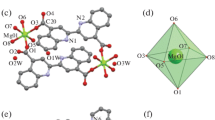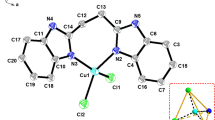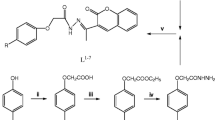Abstract
A new ligand, 3-carbaldehyde chromone-(benzoyl) hydrazone (L), was prepared by condensation of 3-carbaldehyde chromone with benzoyl hydrazine. Its four rare earth complexes have been prepared and characterized on the basis of elemental analyses, molar conductivities, mass spectra, 1H NMR spectra, UV-vis spectra, fluorescence studies and IR spectra. The Sm(III) complex exhibits red fluorescence under UV light and the fluorescent properties of Sm(III) complex in solid state and different solutions were investigated. In addition, the DNA binding properties of the ligand and its complexes have been investigated by electronic absorption spectroscopy, fluorescence spectra, ethidium bromide displacement experiments, iodide quenching experiments, salt effect and viscosity measurements. Experimental results suggest that all the compounds can bind to DNA via an intercalation binding mode. Furthermore, the antioxidant activities of the ligand and its complexes were determined by superoxide and hydroxyl radical scavenging methods in vitro. The rare earth complexes were found to possess potent antioxidant activities that are better than those of the ligand alone.











Similar content being viewed by others
References
Kelland LR (2005) Overcoming the immortality of tumour cells by telomere and telomerase based cancer therapeutics-current status and future prospects. Eur J Cancer 41(7):971–979
Uma V, Kanthimath M, Weyhermuller T, Nair BU (2005) Oxidative DNA cleavage mediated by a new copper (II) terpyridine complex: crystal structure and DNA binding studies. JInorgChem 99(12):2299–2307
Erkkila KE, Odom DT, Barton JK (1999) Recognition and reaction of metallointercalators with DNA. Chem Rev 99(9):2777–2795
Arockiasamy DL, Radhika S, Parthasarathi R, Nair BU (2009) Synthesis and DNA-binding studies of two ruthenium(II) complexes of an intercalating ligand. Eur J MedChem 44(5):2044–2051
Wang BD, Yang ZY, Crewdson P, Wang DQ (2007) Synthesis, crystal structure and DNA-binding studies of the Ln(III) complex with 6-hydroxychromone-3-carbaldehyde benzoyl hydrazone. J Inorg Biochem 101(10):1492–1504
Kumar CV, Barton JK, Turro NJ (1985) Photophysics of ruthenium complexes bound to double helical DNA. J Am Chem Soc 107(19):5518–5523
Xu H, Zheng KC, Chen Y, Li YZ, Lin LJ, Li H, Zhang PX, Ji LN (2003) Effects of ligand planarity on the interaction of polypyridyl Ru(II) complexes with DNA. Dalton Trans 3(11):2260–2268
Mahadvan S, Palaniandavar M (1997) Spectroscopic and voltammetric studies of copper(II) complexes of bis(pyrid-2-yl)-di/trithia ligands bound to calf thymus DNA. Inorg Chim Acta 254(2):291–302
Xu H, Zheng KC, Deng H, Lin LJ, Zhang QL, Ji LN (2003) Effects of the ancillary ligands of polypyridyl ruthenium(III) complexes on the DNA-binding behaviors. New J Chem 27(8):1255–1263
Asadi M, Safaei E, Ranjbar B, Hasani L (2004) Thermodynamic and spectroscopic study on the binding of cationic Zn(II) and Co(II) tetrapyridinoporphyrazines to calf thymus DNA: the role of the central metal in binding parameters. New J Chem 28(10):1227–1234
Bisi CC, Carugo O (1989) Studies on fluorescent lanthanide complexes. New complexes of lanthanides(III) with coumarinic-3-carboxylic acid. Inorg Chim Acta 159(2):157–161
Ci YX, Li YZ, Chang WB (1991) Fluorescence reaction of terbium(III) with nucleic acids in the presence of phenanthroline. Anal Chim Acta 248(2):589–594
Horne DA, Dervan PB (1990) Recognition of mixed-sequence duplex DNA by alternate-strand triple-helix formation. J Am Chem Soc 112(6):2435–2437
Moser HE, Dervan PB (1987) Sequence-specific cleavage of double helical DNA by triple helix formation. Science 238(4827):645–650
Sosnovskikh VY (2003) Synthesis and reactions of halogen-containing chromones. Russ Chem Rev 72(6):489–516
Athanasellis G, Melagraki G, Afantitis A, Makridima K, Markopoulou OI (2006) A simple synthesis of functionalized 2-amino-3-cyano-4-chromones by application of the N-hydroxybenzotriazole methodology. Arkivoc 10:28–34
Singh G, Singh R, Girdhar NK, Ishar MPS (2002) A versatile route to 2-alkyl-/aryl-amino-3-formyl- and hetero-annelated-chromones, through a facile nucleophilic substitution at C2 in 2-(N-methylanilino)-3-formylchromones. Tetrahedron 58(12):2471–2480
Piao LZ, Park HR, Park YK, Lee SK, Park JH, Park MK (2002) Mushroom tyrosinase inhibition activity of some chromones. Chem Pharm Bull 50(3):309–311
Cai YZ, Luo Q, Sun M, Corke H (2004) Antioxidant activity and phenolic compounds of 112 traditional Chinese medicinal plants associated with anticancer. Life Sci 74(17):2157–2184
Heim KE, Tagliaferro AR, Bobilya DJ (2002) Flavonoid antioxidants: chemistry, metabolism and structure-activity relationships. J Nutr Biochem 13(10):572–584
Howe GM, Wu KC, Bauer WR, Lippard SJ (1976) Binding of platinum and palladium metallointercalation reagents and antitumor drugs to closed and open DNAs. Biochem 15(19):4339–4346
Eftink MR, Ghiron CA (1981) Fluorescence quenching studies with proteins. Anal Biochem 114(2):199–227
Kumar CV, Turner RS, Asuncion EH (1993) Groove binding of a styrylcyanine dye to the DNA double helix: the salt effect. J Photochem Photobiol A: Chem 74(2–3):231–238
Eriksson M, Leijon M, Hiort C, Norden B, Graeslund A (1994) Binding of Δ- and Δ-[Ru(phen)3]2+ to [d(CGCGATCGCG)]2 studied by NMR. Biochem 33(17):5031–5040
Xiong Y, He XF, Zou XH, Wu JZ, Chen XM, Ji LN, Li RH, Zhou JY, Yu KB (1999) Interaction of polypyridyl ruthenium(II) complexes containing non-planar ligands with DNA. J Chem Soc, Dalton Trans: Inorg Chem 1:19–24
Winterbourn CC (1979) Comparison of superoxide with other reducing agents in the biological production of hydroxyl radicals. Biochem J 182(2):625–628
Winterbourn CC (1981) Hydroxyl radical production in body fluids. Roles of metal ions, ascorbate and superoxide. Biochem J 198(1):125–131
Nohara A, Umetani T, Sanno Y (1973) Facile synthesis of chromone-3-carboxaldehyde, chromone-3-carboxylic acid, and 3-hydroxymethylchromone. Tetrahedron Lett 14(22):1995–1998
Geary WJ (1971) Use of conductivity measurements in organic solvents for the characterization of coordination compounds. Coord Chem Rev 7(1):81–122
Marchetti F, Pettinari C, Pettinari R, Cingolani A, Leonesi D, Lorenzotti A (1999) Group 12 metal complexes of tetradentate N2O2-Schiff-base ligands incorporating pyrazole: synthesis, characterisation and reactivity toward S-donors, N-donors, copper and tin acceptors. Polyhedron 18(23):3041–3050
Narang KK, Singh VP (1993) Synthesis and characterization of cobalt(II), nickel(II), copper(II) and zinc(II) complexes with acetylacetone bis-benzoylhydrazone and acetylacetone bis-isonicotinoylhydrazone. Transition Met Chem 18(3):287–290
Wang BD, Yang ZY, Zhang DW, Wang Y (2006) Synthesis, structure, infrared and fluorescence spectra of new rare earth complexes with 6-hydroxy chromone-3-carbaldehyde benzoyl hydrazone. Spectrochim acta Part A 63(1):213–219
Lehn JM (1990) Perspectives in supramolecular chemistry: from molecular recognition to molecular information processing and self organization. Angew Chem Int Ed Engl 29(11):1304–1319
Latva M, Takalo H, Simberg K, Ankare KJ (1995) Enhanced EuIII ion luminescence and efficient energy transfer between lanthanide chelates within the polymeric structure in aqueous solutions. J Chem Soc, Perkin Trans 2(5):995–999
Wu SL, Wu YL, Yang YS (1992) Rare earth(iii) complexes with indole-derived acetylacetones II. luminescent intensity for europium(iii) and terbium(iii) complexes. J Alloys Compd 180(2):399–402
Sato S, Wada M (1970) Relations between intramolecular energy transfer efficiencies and triplet state energies in rare Earth β-diketone chelates. Bull Chem Soc Jpn 43(7):1955–1962
Wua WN, Tang N, Yan L (2008) Rare earth complexes with a novel ligand N-(naphthalen-2-yl)-N-phenyl-2-(quinolin-8-yloxy)acetamide: preparation and spectroscopic studies. Spectrochim Acta Part A 71(4):1461–1465
Tang Y, Tang KZ, Liu WS, Tan MY (2008) Assembly, crystal structure, and luminescent properties of three-dimensional (10,3)-a netted rare earth coordination polymers. Sci China, Ser B 51(7):614–622
Latva M, Takalo H, Mukkala VM, Matachescu C, Rodríguez-Ubis JC, Kankare J (1997) Correlation between the lowest triplet state energy level of the ligand and lanthanide(III) luminescence quantum yield. J Lumin 75(2):149–169
Gao F, Chao H, Zhou F, Yuan YX, Peng B, Ji LN (2006) DNA interactions of a functionalized ruthenium(II) mixed-polypyridyl complex [Ru(bpy)2 ppd]2+. J Inorg Biochem 100(9):1487–1494
Pyle AM, Rehmann JP, Meshoyrer R, Kumar CV, Turro NJ, Barton JK (1989) Mixed-ligand complexes of ruthenium(II): factors governing binding to DNA. J Am Chem Soc 111(8):3051–3058
Wilson WD, Ratmeyer L, Zhao M, Strekowski L, Boykin D (1993) The search for structure-specific nucleic acid-interactive drugs: effects of compound structure on RNA versus DNA interaction strength. Biochem 32(15):4098–4104
Xu H, Zheng KC, Lin LJ, Li H, Gao Y, Ji LN (2004) Effects of the substitution positions of Br group in intercalative ligand on the DNA-binding behaviors of Ru(II) polypyridyl complexes. J Inorg Biochem 98(1):87–97
Le-Pecq JB, Paoletti C (1967) A fluorescent complex between ethidium bromide and nucleic acids. J Mol Biol 27(1):87–106
Lee M, Rhodes AL, Wyatt MD, Forrow S, Hartley JA (1993) GC base sequence recognition by oligo(imidazolecarboxamide) and C-terminus-modified analogues of distamycin deduced from circular dichroism, proton nuclear magnetic resonance, and methidiumpropylethylenediaminetetraacetate-iron(II) footprinting studies. Biochem 32(16):4237–4245
Lerman LS (1961) Structural considerations in the interaction of deoxyribonucleic acid and acridines. J Mol Biol 3:18–30
Satyanarayana S, Dabrowiak JC, Chaires JB (1993) Tris(phenanthroline)ruthenium(II) enantiomer interactions with DNA: mode and specificity of binding. Biochem 32(10):2573–2584
Liu JG, Zhang QL, Shi XF, Ji LN (2001) Interaction of [Ru(dmp)2(dppz)]2+ and [Ru(dmb)2(dppz)]2+ with DNA: effects of the ancillary ligands on the DNA-binding behaviors. Inorg Chem 40(19):5045–5050
Liu JG, Ye BH, Li H, Zhen QX, Ji LN, Fu YH (1999) Polypyridyl ruthenium(II) complexes containing intramolecular hydrogen-bond ligand: syntheses, characterization, and DNA-binding properties. J Inorg Biochem 76(3–4):265–271
Wang Q, Yang ZY, Qi GF, Qin DD (2009) Synthesis, crystal structure, antioxidant activities and DNA-binding studies of the Ln(III) complexes with 7-methoxychromone-3-carbaldehyde-(4'-hydroxy) benzoyl hydrazone. Eur J Med Chem 44(6):2425–2433
Proctor PH, Reynolds ES (1984) Free radicals and disease in man. Physiol Chem Phys Med NMR 16(3):175–195
Acknowledgements
This work is supported by the National Natural Science Foundation of China (20475023) and Gansu NSF (0710RJZA012).
Author information
Authors and Affiliations
Corresponding author
Rights and permissions
About this article
Cite this article
Li, Y., Yang, Zy. Rare Earth Complexes with 3-Carbaldehyde Chromone-(Benzoyl) Hydrazone: Synthesis, Characterization, DNA Binding Studies and Antioxidant Activity. J Fluoresc 20, 329–342 (2010). https://doi.org/10.1007/s10895-009-0561-0
Received:
Accepted:
Published:
Issue Date:
DOI: https://doi.org/10.1007/s10895-009-0561-0




